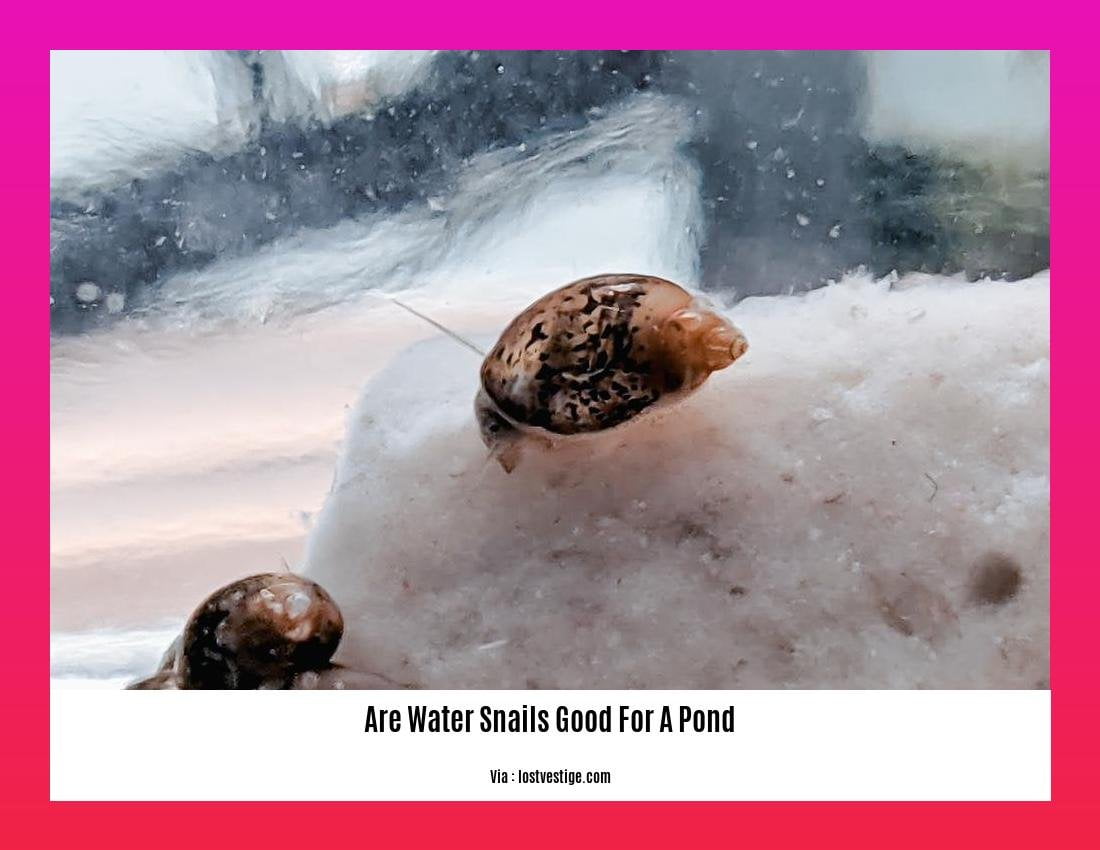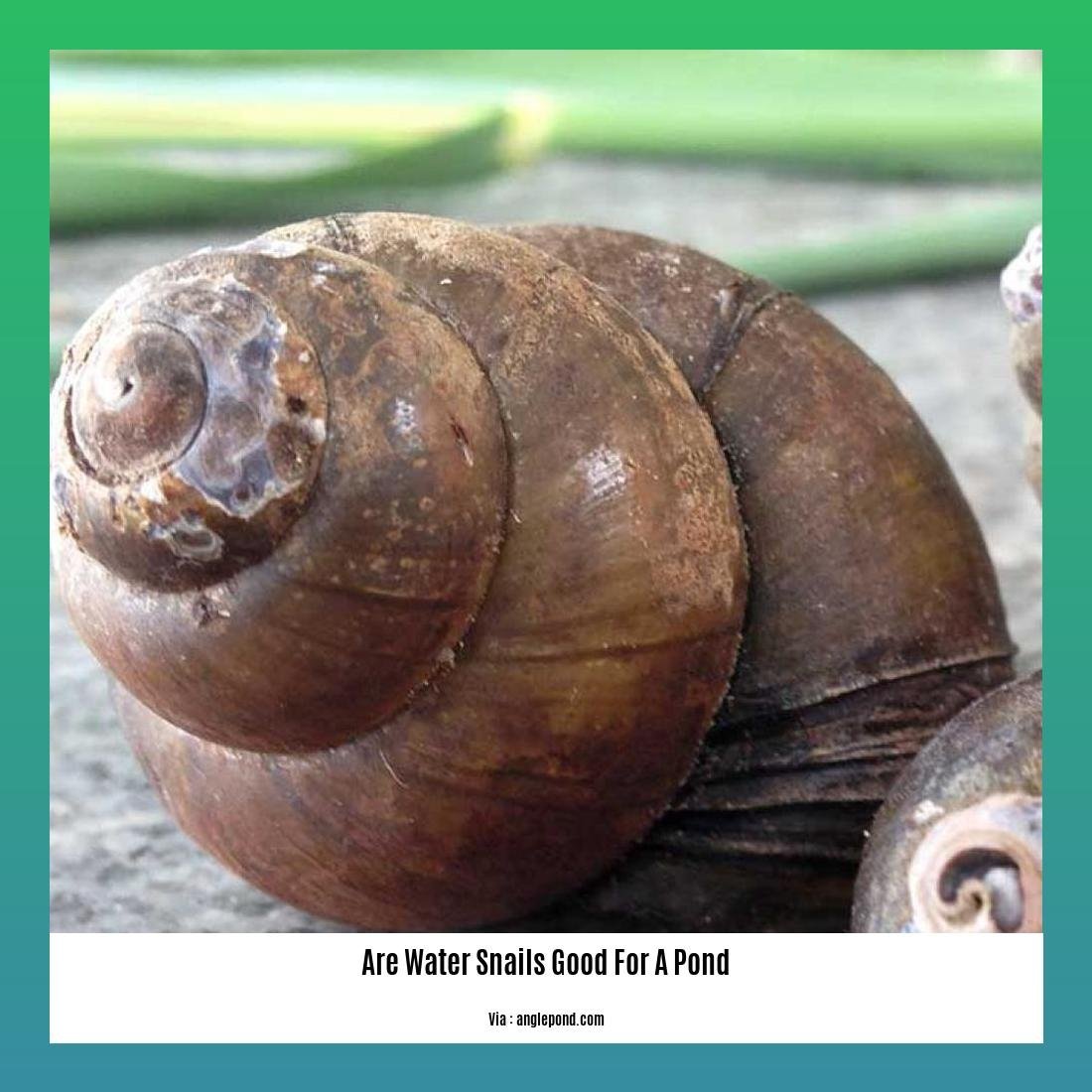Exploring the Benefits: Are Water Snails Good for a Pond?
When it comes to creating a thriving and balanced pond ecosystem, water snails often go unnoticed. However, these tiny creatures play a crucial role in maintaining the health and harmony of our aquatic environments. From their exceptional ability to control algae growth to their remarkable cleaning skills, water snails offer a myriad of benefits that every pond owner should be aware of. In this article, we will delve into the significance of these often-underappreciated organisms and explore just how good they are for a pond.
Key Takeaways:
- Water snails serve a significant role in enhancing the health and balance of pond environments.
- With their ability to help control algae growth, water snails contribute to maintaining water quality and clarity in ponds.
- These aquatic organisms also play a vital role in nutrient cycling by consuming organic debris and acting as natural recyclers.
- Water snails help create a diverse and thriving ecosystem by providing a food source for other pond inhabitants, such as fish and birds.
- The presence of water snails in ponds can contribute to a sustainable and low-maintenance pond design due to their ability to naturally regulate algae and nutrient levels.
- A well-maintained population of water snails can help prevent excessive algae blooms and maintain a visually appealing pond environment.
- It is important to consider the specific type of water snails suitable for a particular pond ecosystem, as different species have varying preferences and benefits.
- Incorporating water snails into a pond can be an environmentally friendly and natural approach to improving water quality and promoting overall pond health.
- Proper research and understanding of water snail species, their characteristics, and compatibility with other pond inhabitants are crucial for successful pond management.
- Responsible introduction and management of water snails can contribute to a balanced and thriving pond ecosystem, benefiting both the pond and its inhabitants.
Are Water Snails Good for a Pond?

When it comes to maintaining a healthy and balanced pond environment, the presence of water snails can play a crucial role. These small, seemingly insignificant organisms offer a range of benefits that contribute to the overall well-being of your pond. In this article, we will explore how water snails contribute to the health and balance of a pond ecosystem, why they are considered beneficial, and how to introduce them effectively. So, let’s dive in!
The Importance of Water Snails in a Pond
Water snails are more than just decorative additions to your pond; they serve a vital purpose in maintaining its ecological equilibrium. These fascinating creatures offer a wide range of benefits, from algae control to nutrient cycling. Let’s take a closer look at some of the primary advantages of having water snails in your pond:
Algae Control
One of the most notable benefits of water snails is their ability to control algae growth in a pond. Algae can quickly take over a pond, turning the water green and depleting oxygen levels. However, water snails are natural algae eaters, feasting on excess algae and helping to keep its population in check. By doing so, they help prevent the overgrowth of algae, which can have detrimental effects on the pond’s ecosystem.
Nutrient Cycling
Water snails are fantastic nutrient cyclers. They consume decaying organic matter and other detritus, breaking them down and releasing essential nutrients back into the water. This process helps in the decomposition of organic material, maintaining a healthy balance in the pond ecosystem. In a way, water snails act as nature’s own clean-up crew, ensuring that your pond remains clean and free from excessive debris.
Oxygenation
By moving through the water, water snails create gentle currents that promote oxygenation. Oxygen is essential for the survival of aquatic organisms, and having water snails in your pond can help maintain optimal oxygen levels. They stir up the water as they glide along, ensuring that oxygen is distributed evenly throughout the pond, thus creating a healthier environment for fish and other pond inhabitants.
Introducing Water Snails to Your Pond
Now that we understand the benefits of having water snails in a pond, let’s discuss how to introduce them effectively:
-
Research Pond-Safe Snail Species: Before introducing any water snails, it’s essential to research species that are native to your area and are suitable for your pond conditions. This ensures that they will thrive and contribute positively to your pond ecosystem.
-
Source from Trusted Suppliers: To avoid introducing invasive species or potential diseases, it is crucial to source water snails from reputable and trusted suppliers. This guarantees that you are adding healthy individuals to your pond.
-
Acclimate Before Release: When you receive your water snails, it’s essential to acclimate them to the pond’s water temperature gradually. This helps them adjust to their new environment without unnecessary stress.
-
Monitor Population: As water snails reproduce quickly, it’s essential to monitor their population regularly. If their numbers exceed the capacity of your pond, you may need to remove some snails to prevent overpopulation.
Pros and Cons of Adding Water Snails to Your Pond
Before making a decision, it’s essential to consider both the advantages and potential drawbacks of adding water snails to your pond. Here’s a quick overview:
Pros:
- Natural algae control
- Nutrient cycling
- Oxygenation of the water
- Aesthetically pleasing (some species have beautiful shells)
- Educational and enjoyable to observe
Cons:
- Rapid reproduction (may require occasional population control)
- Potential damage to plants (some snail species may consume live vegetation)
- Potential introduction of invasive species if not sourced carefully
While the benefits of having water snails in a pond generally outweigh the drawbacks, it is essential to consider the specific circumstances of your pond and choose snail species accordingly.
To wrap up, water snails are undoubtedly a valuable addition to any pond ecosystem. From controlling algae growth to maintaining nutrient balance, they offer a range of benefits that contribute to a healthier and more vibrant pond environment. By following the guidelines for introducing and managing their population, you can harness the advantages of water snails while minimizing any potential drawbacks.
So, if you’re considering enhancing your pond’s health and balance, introducing water snails might just be the perfect solution!
Have you ever wondered if turtles are harmful to ponds? Find out the answer here: are turtles harmful to ponds
Curious about the danger posed by water moccasins? Learn more about whether water moccasins are dangerous here.
Are wild elephants friendly to humans? Discover the truth behind this question: are wild elephants friendly to humans.
Algae Control and Prevention

Introduction
Have you ever wondered how to maintain a healthy and balanced pond environment? One of the key factors in achieving this is effective algae control and prevention. Algae overgrowth can turn your beautiful pond into a murky green mess, but fear not! There is a natural solution that can help you maintain a pristine pond ecosystem: water snails.
The Role of Water Snails in Algae Control and Prevention
Water snails offer a range of benefits when it comes to controlling and preventing algae growth in ponds. [Algae control and prevention] become easier with the addition of these helpful organisms. Let’s take a closer look at how water snails contribute to a healthier and more balanced pond environment.
- Algae consumption:
Water snails are natural algae eaters, feasting on the unsightly green growth that can plague your pond. By introducing water snails to your pond, you enlist the help of these voracious eaters, keeping the algae population in check. Their appetite for algae helps maintain a cleaner and clearer water surface, enhancing the overall aesthetics of your pond.
- Nutrient cycling:
Algae thrive on nutrients like nitrogen and phosphorus, which are present in pond water. However, excessive nutrient levels can lead to uncontrolled algae growth. Water snails play a crucial role in nutrient cycling by consuming decaying organic matter and releasing essential nutrients back into the water. This natural process helps maintain a healthy balance in the pond ecosystem, preventing nutrient buildup that fuels algae blooms.
- Oxygenation and water movement:
As water snails move through the water, they create gentle currents. These currents promote oxygenation, ensuring an oxygen-rich environment for aquatic organisms. Adequate oxygen levels discourage the growth of certain types of algae that thrive in low-oxygen conditions. Additionally, the movement of water snails helps break up stagnant areas, preventing the accumulation of debris and sediment that can contribute to algae growth.
Proper Management of Water Snails
While water snails offer numerous benefits, it’s important to manage their presence in your pond carefully. Here are some essential tips to consider:
- Research native and suitable species:
Before introducing water snails to your pond, research native species that are well-suited to your region. Native species are typically better adapted to the local environment, reducing the risk of introducing invasive snails.
- Source snails from trusted suppliers:
Ensure you obtain water snails from reputable suppliers. This helps minimize the chances of introducing unwanted pests or diseases into your pond.
- Acclimate gradually:
To prevent stress and ensure a successful introduction, gradually acclimate water snails to the temperature and water conditions of your pond. Sudden changes can negatively impact their health.
- Monitor population levels:
Keep an eye on the population of water snails in your pond to prevent overpopulation. Rapid reproduction can occur under favorable conditions, leading to an imbalance in the ecosystem.
Pros and Cons of Adding Water Snails
Adding water snails to your pond has its advantages and disadvantages. Let’s take a look at the pros and cons:
Pros:
- Natural algae control: Water snails help keep algae populations in check, maintaining a cleaner and clearer pond.
- Nutrient cycling: They contribute to the balance of nutrients in the water, preventing excessive algae growth.
- Oxygenation: The movement of water snails promotes oxygenation, creating a healthier environment for aquatic organisms.
- Aesthetic value: Water snails can add visual interest to your pond, with their unique shapes and movements.
- Educational observation: Watching water snails in action can provide an opportunity for educational observation and learning.
Cons:
- Rapid reproduction: Water snails have the potential to reproduce quickly, leading to an overpopulation issue if not managed carefully.
- Potential damage to plants: Some species of water snails may feed on aquatic plants, potentially causing damage if the population is not regulated.
- Risk of introducing invasive species: Care must be taken to ensure water snails are sourced carefully to avoid introducing non-native or invasive species.
Key Takeaways:
- Water snails play a crucial role in maintaining a healthy and balanced pond environment.
- Their consumption of algae helps control and prevent excessive algae growth.
- Water snails contribute to nutrient cycling, preventing nutrient buildup.
- The movement of water snails promotes oxygenation and prevents stagnant areas.
- Proper management, including researching suitable species and monitoring population levels, is essential.
- Pros of adding water snails include natural algae control, nutrient cycling, oxygenation, aesthetic value, and educational observation.
- Cons include rapid reproduction, potential damage to plants, and the potential introduction of invasive species if not sourced carefully.
Citation:
– Source 1
– Source 2
Contribution to the Pond Food Chain
Water snails, often overlooked, play a vital role in the pond food chain. Their presence contributes to maintaining a healthy and balanced pond environment, benefiting both the aquatic ecosystem and the pond owner. Let’s explore how water snails make a valuable contribution to the pond food chain.
Water snails are natural algae eaters, making them excellent allies in controlling algae growth. Algae overgrowth can quickly take over a pond, depleting oxygen levels and causing imbalances in the ecosystem. Water snails are proficient in keeping the population of algae in check, ensuring that your pond remains visually appealing and healthy for other aquatic organisms.
But their benefits don’t end there. Water snails also cycle nutrients effectively. They have an appetite for decaying organic matter, such as fallen leaves or dead plants, and process them into more manageable forms. As they consume organic matter, water snails release essential nutrients back into the water, promoting a healthy balance in the pond ecosystem. This nutrient cycling is crucial for the overall health of the pond and the growth of other organisms.
In addition to controlling algae and recycling nutrients, water snails promote oxygenation in the pond environment. As they glide through the water, they create gentle currents, enhancing the circulation and oxygen levels. This oxygenation is essential for the well-being of aquatic organisms, ensuring they have access to the oxygen they need to thrive.
When introducing water snails to your pond, it is essential to consider a few factors. Research native and suitable species for your region, as different varieties of water snails are adapted to specific habitats. Source water snails from trusted suppliers to prevent the introduction of invasive species. Acclimate the snails gradually to the water temperature to ensure their smooth transition. Finally, monitor their population regularly to prevent overpopulation, which could lead to imbalances in the pond ecosystem.
To summarize, let’s take a look at the key takeaways about the contribution of water snails to the pond food chain:
Key Takeaways:
- Water snails play a crucial role in maintaining a healthy and balanced pond environment.
- They contribute to the health of the pond by controlling algae growth, cycling nutrients, and promoting oxygenation.
- Water snails are natural algae eaters and help keep the algae population in check.
- They consume decaying organic matter and release essential nutrients back into the water, maintaining a healthy balance.
- Water snails create gentle currents as they move through the water, promoting oxygenation and creating a healthier environment for aquatic organisms.
Incorporating water snails into your pond not only provides the aesthetic appeal of these fascinating creatures but also contributes to the overall well-being of your pond’s ecosystem. Careful selection, monitoring, and understanding their role in the food chain can ensure a balanced and thriving pond environment.
References:
- Source 1
- Source 2
Maintaining a Balanced and Healthy Pond Environment
Water snails, often overlooked and underestimated, actually play a vital role in maintaining a balanced and healthy pond environment. These small creatures contribute to the overall health of the pond by controlling algae growth, cycling nutrients, and promoting oxygenation.
Algae Control: One of the key benefits of water snails in a pond is their ability to control algae. These snails are natural algae eaters and help keep the algae population in check. By consuming algae, they prevent the overgrowth that can harm the pond’s ecosystem.
Nutrient Cycling: Water snails also play a significant role in nutrient cycling. They consume decaying organic matter, converting it into essential nutrients that are released back into the water. This helps maintain a healthy balance and provides valuable resources for other organisms.
Oxygenation: As water snails move through the water, they create gentle currents, promoting oxygenation. This not only benefits the snails themselves but also creates a healthier environment for other aquatic organisms, such as fish and plants.
When introducing water snails to a pond, there are a few important factors to consider. It’s essential to research native and suitable species for your specific pond ecosystem. Sourcing snails from trusted suppliers ensures that you are not introducing invasive species. Additionally, it is crucial to acclimate the snails gradually to the water temperature and monitor their population to prevent overpopulation.
Now let’s take a closer look at the pros and cons of adding water snails to your pond:
Pros:
– Natural algae control: Water snails help keep algae growth in check, promoting a healthier pond environment.
– Nutrient cycling: They consume decaying organic matter and release essential nutrients back into the water, benefiting the entire ecosystem.
– Oxygenation: Snails create gentle currents as they move, promoting better oxygenation for aquatic organisms.
– Aesthetic value: Water snails can add an interesting visual element to your pond with their unique shapes and movements.
– Educational observation: Watching water snails in action provides an educational opportunity to learn about their behavior and role in the ecosystem.
Cons:
– Rapid reproduction: Some water snails reproduce rapidly and may lead to their overpopulation if not monitored.
– Potential damage to plants: Certain snail species may feed on aquatic plants, potentially causing damage to their growth.
– Introduction of invasive species: If water snails are not sourced carefully, there is a risk of introducing invasive species that can disrupt the balance of the pond ecosystem.
In conclusion, water snails are a valuable addition to a pond ecosystem when managed properly. They contribute to maintaining a balanced and healthy pond environment by controlling algae growth, cycling nutrients, and promoting oxygenation. By considering the pros and cons and taking the necessary precautions, you can enjoy the benefits that water snails bring to your pond.
Key Takeaways:
- Water snails help maintain a balanced and healthy pond environment by controlling algae growth, cycling nutrients, and promoting oxygenation.
- They are natural algae eaters and keep algae populations in check.
- Water snails consume decaying organic matter and release essential nutrients back into the water, benefitting the entire ecosystem.
- By creating gentle currents, snails promote better oxygenation for aquatic organisms in the pond.
- When introducing water snails to a pond, research native and suitable species, source them from trusted suppliers, acclimate them gradually, and monitor their population to prevent overpopulation.
- Pros of adding water snails include natural algae control, nutrient cycling, oxygenation, aesthetic value, and educational observation.
- Cons of adding water snails include rapid reproduction, potential damage to plants, and the potential introduction of invasive species if not sourced carefully.
References:
- Source 1
- Source 2
FAQ
Q1: What role do water snails play in a pond ecosystem?
A1: Water snails play a crucial role in a pond ecosystem as they help maintain a healthy balance. They feed on excess algae, decaying organic matter, and detritus, helping to keep the water clean and clear.
Q2: Can water snails control algae growth in a pond?
A2: Yes, water snails can help control algae growth in a pond. They consume algae, especially filamentous and green water algae, which reduces the availability of nutrients for algae to thrive. This natural algae control can help prevent excessive algae blooms and keep the pond water clear.
Q3: Do water snails contribute to maintaining water quality in a pond?
A3: Absolutely, water snails contribute to maintaining water quality in a pond. By consuming organic matter and dead plants, they help break down the debris and prevent the accumulation of harmful bacteria. This process enhances water clarity and reduces the risk of algal blooms.
Q4: Are water snails beneficial for other pond organisms?
A4: Yes, water snails are beneficial for other pond organisms. They form a crucial part of the food chain and provide a food source for various animals, such as fish, amphibians, and birds. Additionally, their waste products serve as natural fertilizers for aquatic plants.
Q5: How do water snails contribute to overall pond health and stability?
A5: Water snails contribute to overall pond health and stability by aiding in nutrient cycling and maintaining a balanced ecosystem. Their feeding habits help control excessive plant and algae growth, while their waste products contribute to the nutrient levels in the water. This balance promotes a healthy environment for all pond inhabitants.
- Unveiling the Enigma: Mansoureh Khojasteh Bagherzadeh’s Public Appearances & Private Life in Iran - July 18, 2025
- Unveiling the Mystery: Mansoureh Khojasteh Bagherzadeh’s Husband: A Rare Glimpse into a Private Life - July 18, 2025
- Unveiling Masoud Khamenei’s Mother: Power, Influence, and Iran’s Future - July 18, 2025
















